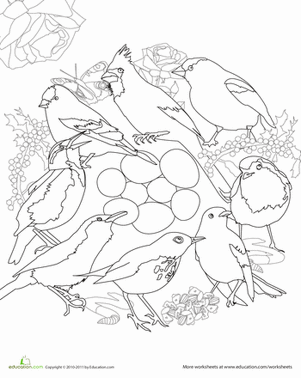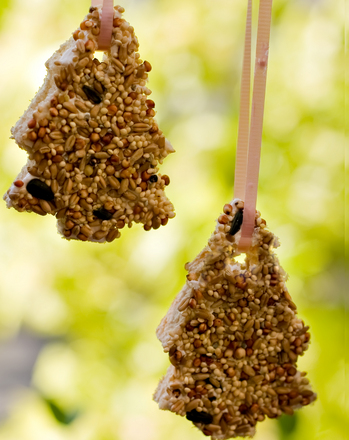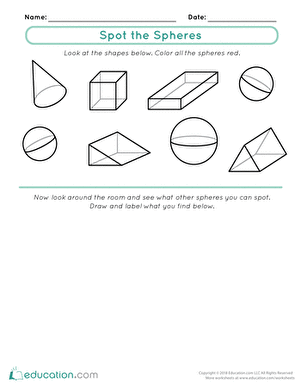Science project
Watching Birds at a Sit Spot
It's a plane, it's Superman, it's ... a colorful bird?!
Birds are good at hiding—if they hear or see you, they'll fly away. By watching birds and learning how to become an accomplished observer offeathered friends, you'll enjoy hours of birdwatching in your own backyard or neighborhood park.
Problem:
Discover which birds live close by, and learn what they're saying and doing throughout the seasons.
Materials:
- Pencil
- Notebook
- A guide to different birds, such as National Geographic Field Guide to the Birds of North America
- Bird sounds website
Procedure:
- Find a place near your home that has a lot of birds. This is your sit spot where you'll sit quietly to listen and watch what's around you. It's best to find a place that you can visit a lot—the more time you spend with your birds, the more you'll learn about them.
- At your sit spot, look and listen for birds.
- Using either pictures or written notes, describe the birds that you see and hear in your notebook. What colors are they? Where do they fly? Where do they eat? What sounds do they make?
- Identify the fowl perched around you using your bird book. If you see or hear a bird that you don't recognize, you may have stumbled upon a migrating species that doesn't visit your neighborhood very often.
- After you have discovered some birds in your area, it's time to learn their language! Check out a website such as What Bird, that'll help you learn their calls and songs. Compare the birds you've recognized in your area to the sounds you hear.
- Can you recognize any of the birds from the pictures you saw or the sounds you heard? Do you hear birds that you don't recognize? Write any notes in your notebook.
- To count the number of birds you see, keep a tally of each group of birds that you come across. For example, you might see ten chickadees in the morning, then two chickadees in the evening. Even though that's ten birds total, only count the largest group you've seen—in this case, eight—since birds move around, and the two chickadees may have been part of the group of ten.
- Look at the area around your sit spot for bird meal leftovers. Even if you can't see any wrens, hummingbirds or any feathered flier at your sit spot, birds leave lots of clues. Look for bits of seeds and pecked berries, search for bird scat (poo) on the ground, and look at what's in it. Record any clues in your notebook.
- In the spring and summer months, look for nests and try to figure out what the nest is made from: this will help you figure out who built it!
- Visit your sit spot again and again and continue watching birds. Take notes and draw pictures of the birds you see, sounds you hear and clues that tell you more about your feathered friends.
Results:
You've learned a lot about which birds live around your neighborhood, what they eat, where they fly and even where they like to nest, which makes you a citizen scientist! Citizen scientists are people like you who love to visit natural places and learn about them. Use your results to help let other scientists know what's happening to the bird populations in your area. Let the National Audubon Society know about what you've learned through their annual bird counts.
You can also use your results to make plans to help the birds in your local area. When people noticed that purple martins were disappearing, they made special houses that helped them find new homes. Do you see a bird that you could help?
Why?
Birds are very private creatures; it takes time to earn their trust. When you sit quietly in the forest, birds realize that you're not so dangerous after all. They'll start doing their usual routine again: eating berries and seeds, singing songs, and building nests. Soon, you'll be able to watch the different bird species and track their behavior throughout the year.
As you were watching birds, what do you see and hear? Do you notice that the birds' habits and the types of birds change through the seasons? Over time, you'll start to see patterns in the birds that you see and hear. You'll notice the time when migratory birds come back and the times when winter birds begin to arrive.
Around the world, scientists rely on amateur bird scientists—also known as ornithologists—to track what's going on with bird populations. By sending in your observations to the Audubon Society or other local bird monitoring programs, you can help scientists understand what's going on with the birds in your neighborhood and across the country.
Education.com provides the Science Fair Project Ideas for informational purposes only. Education.com does not make any guarantee or representation regarding the Science Fair Project Ideas and is not responsible or liable for any loss or damage, directly or indirectly, caused by your use of such information. By accessing the Science Fair Project Ideas, you waive and renounce any claims against Education.com that arise thereof. In addition, your access to Education.com's website and Science Fair Project Ideas is covered by Education.com's Privacy Policy and site Terms of Use, which include limitations on Education.com's liability.
Warning is hereby given that not all Project Ideas are appropriate for all individuals or in all circumstances. Implementation of any Science Project Idea should be undertaken only in appropriate settings and with appropriate parental or other supervision. Reading and following the safety precautions of all materials used in a project is the sole responsibility of each individual. For further information, consult your state's handbook of Science Safety.













